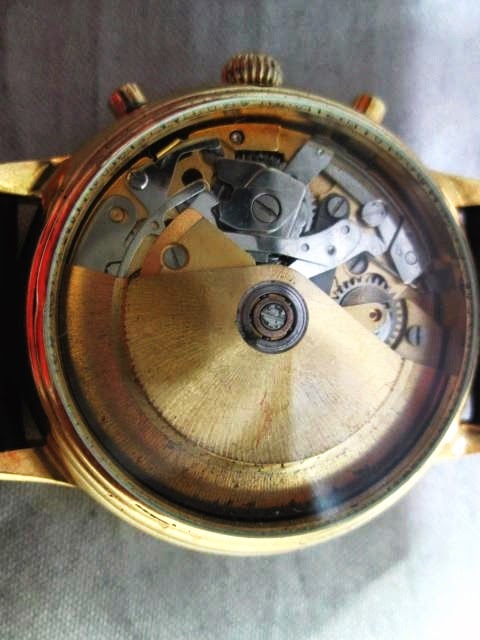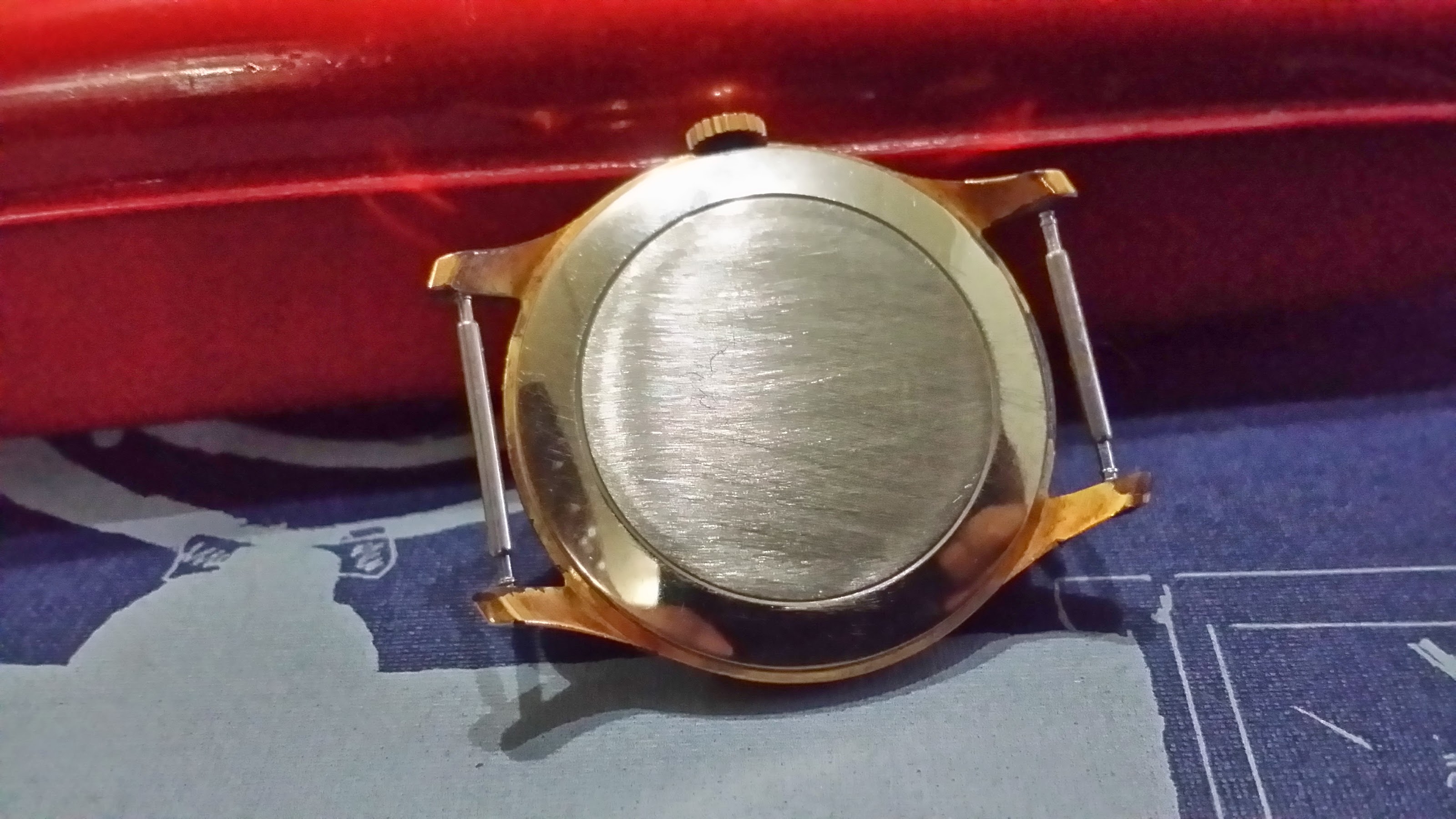BRAND: VINTAGE GIRARD PERREGAUX MILITARY BROAD ARROW GENTS WRISTWATCH
MADE IN: SWISS
CIRCA: 1940's
MODEL: T MILITARY BROAD ARROW
CRYSTAL: ACRYLIC CLEAN
MOVEMENT: SWISS A.SHIELD 17 JEWELS MANUAL MOVEMENT
DIAL COLOR: BLACK
FUNCTIONS: -HOUR, MINUTE & SUB SECOND
HANDS: GOLD TONE DAUPHINE HANDS
MARKERS: LUMINOUS ARABIC MILITARY (RE-LUMED)
CASING : ROSE GOLD FILLED & STAINLESS STEEL BACK
LUGS: 19mm
MEASUREMENT: 35mm DIAMETER w/o CROWN and 42mm LUG TO LUG
BACK CASE MARKING: none
CROWN: GOLD PLATED
STRAP: GENUINE NEW OLD STOCK BLACK TEXTILE MILITARY STRAP MADE IN WEST GERMANY
STRAP SIZE: 8.5"
DISCONTINUED MODEL & HARD TO FIND
PRICE: RM3,500 (NEGOTIABLE)
THE BRIEF HISTORY OF GIRARD PERREGAUX WATCH
The history of this prestigious Swiss manufacturer can be traced back to Jean-Francois Bautte, the famous Geneva watchmaker. Though orphaned at a very young age, the young man confronted life with determination. In 1791, by the time he was nineteen, Jean-Francois Bautte had learnt several trades, acquired the education which his modest background had denied him, and begun making his first watches. It would not be long before his name became familiar to the royal courts of Europe. A master watchmaker of rare talent, Jean-Francois Bautte was also an astute "industrialist" and businessman with a brilliant, imaginative and generous character. He is credited with creating the first genuine ultra-thin watches and the truly visionary concept of the Manufactory as a producer of high-quality timepieces.
Unfortunately, Jean-Francois Bautte did not have a successor or heir to take over his company when he retired. The problem of what to do with the company was quickly solved when a merger was arranged with another watch manufacturer. In 1854, Constantin Girard married Marie Perregaux. As both came from watchmaking backgrounds, it seemed perfectly natural to use both names when they formed their own company. So it was that the Girard-Perregaux brand was born, in 1856.
More than just a famous watchmaker, Constantin Girard was also a patriot committed to the republican cause and always ready to devote time and energy to his beloved town of La Chaux-de-Fonds. Only a few years were needed to establish a reputation that spread as far as the New World. His technical and aesthetic masterpiece, the "Tourbillon Sous Trois Points d'Or" (translation: Tourbillon with Three Gold Bridges), was unquestionably the greatest achievement of a life largely devoted to the research and development of the art of watchmaking. This amazing pocket watch won Girard-Perregaux two gold medals at the Paris Universal Exhibitions in 1867 and 1889, and is considered one of the most desirable mechanical watches ever made.
The tradition of innovation initiated by Jean Francois Bautte has been perpetuated to the present day by Girard-Perregaux. Throughout its long history, the Manufactory has made a number of exciting and innovative contributions to the world of watchmaking. Foremost among these is the concept of the wristwatch. Although a few pocket watches had already been modified to be worn on the wrist, Girard-Perregaux was the first watchmaker to produce this kind of timepiece in a series, around 1880.
In addition, Girard-Perregaux has developed several revolutionary movements, the most notable of which have been the Gyromatic, the high-frequency mechanical movement that has become collectible in their own right, as well as the quartz movement, whose frequency of 32,768 Hertz has become the universally accepted standard. In fact, it was Girard-Perregaux's innovations in the realm of quartz timekeeping that allowed it to survive the Swiss watch industry's economic crisis during the 1970's and 1980's.
Although Girard-Perregaux did not thrive during the 1970's and early 1980's, unlike other Swiss watch companies, Girard-Perregaux not only survived fully intact, but emerged even stronger than before and fiercely determined to continue producing high-quality mechanical timepieces using in-house movements. At a time when many prestigious Swiss companies were looking to outside suppliers for their raw movements, Girard-Perregaux simply would not compromise quality to improve the bottom line.
The company's massive efforts to upgrade their factory, while training a new generation of master watchmakers to produce the highest quality wristwatches, was clearly a gamble but one which paid off handsomely when consumers re-discovered the pleasures of wearing traditionally hand-finished mechanical timepieces.
Girard-Perregaux's master watchmakers continued their efforts in the early 1980's. After extensively studying an original model acquired at auction, the watchmakers revived the expertise, which had originally created the Tourbillon with Three Gold Bridges pocket watch. To make a replica of this marvel, however, they had to think in modern terms and re-design all the components. Although computers would prove helpful in the design phase, the watchmakers nonetheless had to re-learn all the traditional crafts and skills that had died along with the masters.
In 1991, on the occasion of its 200th anniversary, the company achieved the amazing feat of adapting the technology of the Tourbillon with Three Gold Bridges to a wristwatch version. Several variations have been produced since then. These watches, which are completely handmade in Girard-Perregaux's workshops, are amazing works of mechanical art, and the Three Bridges, which are cast in solid gold, are stunningly beautiful to behold. Some six to eight months of continuous work are needed to produce such a watch, with the House's most talented senior watchmakers meticulously crafting each component by hand, assembling the movement, testing the complicated mechanism and finally casing up the completed movement in a massive gold or platinum case. As of this writing, only 20 such Tourbillon wristwatches have been produced to date.
Needless to say, watch lovers around the world quickly took notice of the company's amazing comeback, and the company capitalized even further on its newfound success by obsessively dedicating itself to the production of wristwatches of the highest quality at extremely competitive prices. Moreover, in 1993, Girard-Perregaux signed a co-branding arrangement with the celebrated Italian car manufacturer, Ferrari, which has yielded a remarkable line of sporty chronographs.
Along with the Ferrari chronographs, the company's other popular models include the Vintage Men's automatic, which features an in-house Girard-Perregaux 3000 self-winding calibre; the Chronograph 9000, featuring a refined self-winding movement which can be viewed through a sapphire-crystal back; and the Olympic Chrono 1992, which boasts an in-house Girard-Perregaux chronograph movement.
In summary, Girard-Perregaux offers one of the highest quality wristwatches available in the contemporary watch marketplace. Best of all, these watches can be obtained at very favorable prices for collectors.



















































